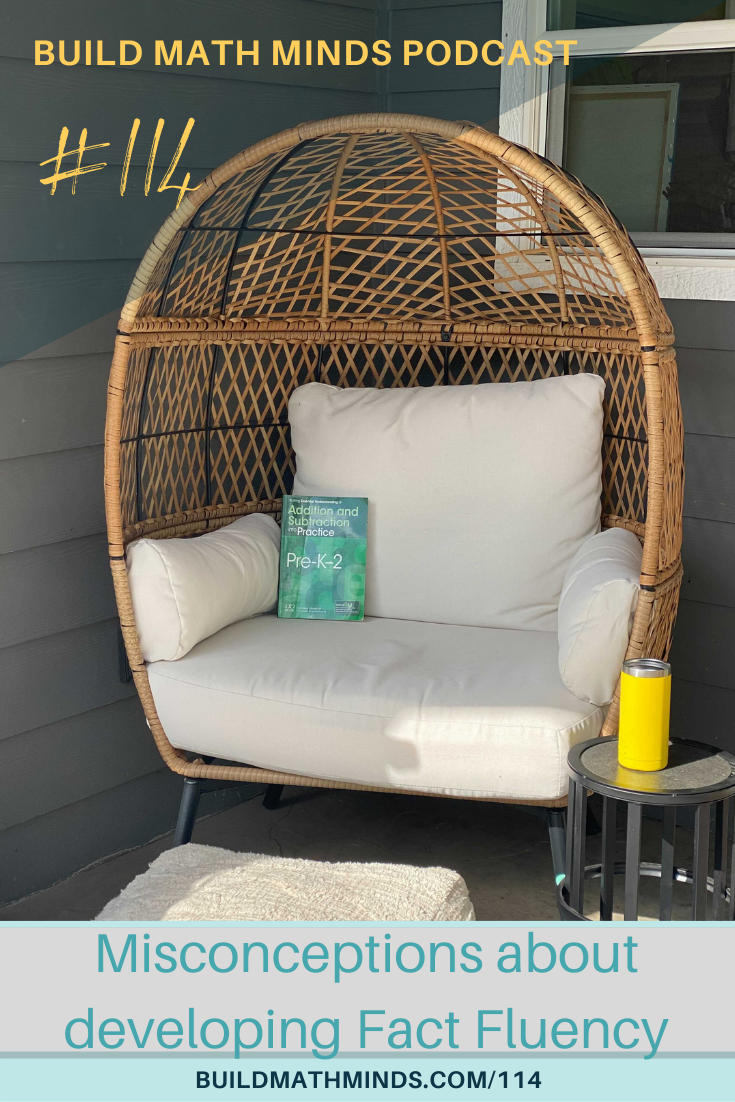Resources mentioned in this episode:
A Big Mistake Educators Make When Building Math Fluency video training
Putting Essential Understanding of Addition and Subtraction into Practice in PreK-Grade 2 By Janet H. Caldwell, Beth Kobett, and Karen Karp; Karen Karp, Volume Editor; Barbara J. Dougherty, Series Editor, Putting Essential Understanding into Practice Series
Welcome fellow Recovering Traditionalists to Episode 114. Today we are taking a look at some Misconceptions About Developing Fact Fluency.
Recently I did a video over on my vlog about A Big Mistake Educators Make When Building Math Fluency. The mistake is that we directly teach students strategies.
Then I was looking through the book Putting Essential Understanding of Addition and Subtraction into Practice in PreK-Grade 2, I came across a section that described a lot of what I was trying to convey in my video just in a different way.
Now, I know this is from a PreK-Grade 2 book, but if you are an upper elementary teacher, as I read this section, think about how this applies to your situation. Are you teaching multiplication or division in this same way??
On page 77 it says:
“When students are exposed to all the common basic fact strategies in rapid succession, without opportunities to apply or make sense of them, they often become confused about how or when to apply a particular strategy, and instead they resort to a ‘count all’ strategy. For example, students often develop misconceptions about the use of the ‘count on’ strategy, which is best reserved for those facts that include an addend of 1,2, or 3. Yet, students frequently apply this strategy to find any fact, even when using it is a laborious and time-consuming process. For instance, they may use it in determining the sum 8 + 9, counting on 9 more from 8.
Another misconception commonly held by students – and sometimes by teachers-is the notion that it is necessary to adhere rigidly to a specific strategy. For example, students might be taught that finding the sum 7 + 9 automatically calls for a ‘doubles plus 2’ strategy and no other strategy, such as ‘make 10’ or ‘inside doubles.’ When students think that they must use a specific strategy to find designated facts, they become overwhelmed by what they perceive as the need to choose the correct strategy. Frustrated, they may resort to drawing circles, counting on their fingers, or bobbing their heads to count by ones to the total.”
So, have you ever taught ‘fact strategies in rapid succession without opportunities to apply or make sense of them’?? Have you seen your students get stalled by the overwhelm of trying to think through which strategy is the right strategy?? Do you have students who have been taught the strategies but then revert back to counting?
This happens with addition problems, this happens with multiplication problems, it happens with subtraction, it happens with division. It happens when kids are taught the strategies instead of helping kids build their sense of numbers so that they develop strategies on their own.
It’s not easy moving away from the direct teaching of strategies and trusting that your students will just come up with them on their own….and really they won’t come up with the strategies on their own until they develop relationships around numbers. When they learn to think flexibly with numbers, they will develop their own strategies for operating with those numbers.
I’ve got some webinars coming up that will actually help you learn how to do that….and they are completely free.
I’m doing a webinar about The Missing Piece to Elementary Math Fluency. No matter what grade, all elementary kids are working on developing their fluency. But being fluent is more than just getting correct answers quickly. Come join me on this live, free training to learn the missing piece to developing fact fluency and learn how to help your students build the strategies themselves and not you directly teaching them the strategies. Just go to buildmathminds.com/webinar to sign up for free.
If you work with younger kids, I’m also hosting Sue Looney’s webinars about The Power of Counting. In The Power of Counting webinar, you will learn the 3 reasons why counting is so powerful, and how you can use this information to help your students build a strong foundation in number sense. You will learn a step by step approach that leads to mathematical understanding and deep number sense. The road to developing strategies starts with the power of counting with our young learners. Go to buildmathminds.com/counting-webinar to sign up for Sue’s webinar.
Subscribe and Review in iTunes
Hey, are you subscribed to the Build Math Minds Podcast, yet? If you’re not, make sure to do that today because I don’t want you to miss any episodes! Click here to subscribe to the podcast in iTunes.
While you’re there, don’t forget to leave a review on iTunes too. I would love to know your thoughts and how we can make sure that we give you content that you will really enjoy.
To leave a review, head over to iTunes and click on “Ratings and Reviews” and “Write a Review.” I can’t wait to hear your thoughts about the podcast.




